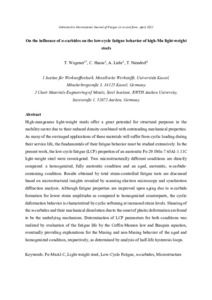| dc.date.accessioned | 2023-12-22T13:13:32Z | |
| dc.date.available | 2023-12-22T13:13:32Z | |
| dc.date.issued | 2021 | |
| dc.identifier | doi:10.17170/kobra-202311309137 | |
| dc.identifier.uri | http://hdl.handle.net/123456789/15324 | |
| dc.description | © This manuscript version is made available under the CC-BY-NC-ND 4.0 license https://creativecommons.org/licenses/by-nc-nd/4.0/ | eng |
| dc.language.iso | eng | |
| dc.rights | Attribution-NonCommercial-NoDerivatives 4.0 International | * |
| dc.rights.uri | http://creativecommons.org/licenses/by-nc-nd/4.0/ | * |
| dc.subject | Fe-MnAl-C | eng |
| dc.subject | light-weight steel | eng |
| dc.subject | low-cycle fatique | eng |
| dc.subject | ϰ-carbides | eng |
| dc.subject | microstructure | eng |
| dc.subject.ddc | 600 | |
| dc.subject.ddc | 660 | |
| dc.title | On the influence of ϰ-carbides on the low-cycle fatigue behavior of high-Mn light-weight steels | eng |
| dc.type | Aufsatz | |
| dcterms.abstract | High-manganese light-weight steels offer a great potential for structural purposes in the mobility sector due to their reduced density combined with outstanding mechanical properties. As many of the envisaged applications of these materials will suffer from cyclic loading during their service life, the fundamentals of their fatigue behavior must be studied extensively. In the present work, the low-cycle fatigue (LCF) properties of an austenitic Fe-29.8Mn-7.65Al-1.11C light-weight steel were investigated. Two microstructurally different conditions are directly compared: a homogenized, fully austenitic condition and an aged, austenitic, ϰ-carbide-containing condition. Results elaborated by total strain-controlled fatigue tests are discussed considering microstructural insights revealed by scanning electron microscopy and synchrotron diffraction analysis. Although fatigue properties are improved upon aging due to ϰ-carbide formation for lower strain amplitudes as compared to homogenized counterparts, the cyclic deformation behavior is characterized by cyclic softening at increased strain levels. Shearing of the ϰ-carbides and their mechanical dissolution due to the onset of plastic deformation are found to be the underlying mechanisms. Determination of LCF parameters for both conditions was realized by evaluation of the fatigue life based on the Coffin-Manson law and Basquin equation, eventually providing explanations for the Masing and non-Masing behavior of the aged and homogenized condition, respectively, deduced from analysis of half-life hysteresis loops. | eng |
| dcterms.accessRights | open access | |
| dcterms.creator | Wegener, Thomas | |
| dcterms.creator | Haase, Christian | |
| dcterms.creator | Liehr, Alexander | |
| dcterms.creator | Niendorf, Thomas | |
| dc.relation.doi | doi:10.1016/j.ijfatigue.2021.106327 | |
| dc.subject.swd | Legierung | ger |
| dc.subject.swd | Leichtbau | ger |
| dc.subject.swd | Stahl | ger |
| dc.subject.swd | Ermüdung bei niedrigen Lastspielzahlen | ger |
| dc.subject.swd | Carbide | ger |
| dc.subject.swd | Mikrostruktur | ger |
| dc.subject.swd | Mechanische Eigenschaft | ger |
| dc.type.version | acceptedVersion | |
| dcterms.source.identifier | eissn:1879-3452 | |
| dcterms.source.journal | International Journal of Fatigue | eng |
| dcterms.source.volume | Volume 150 | |
| kup.iskup | false | |
| dcterms.source.articlenumber | 106327 | |


